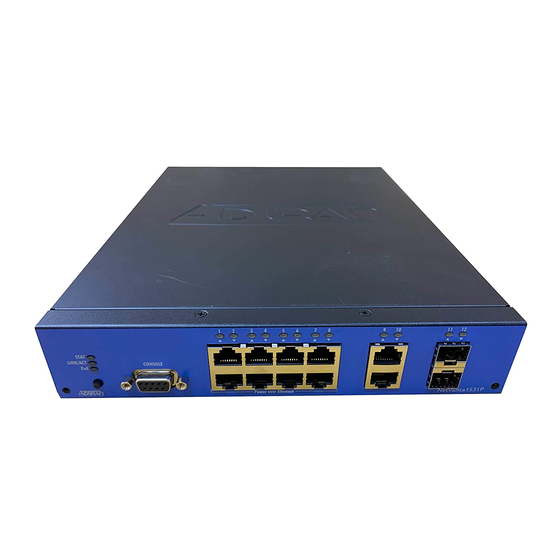Table of Contents
Advertisement
Quick Links
N
V
1531 S
ET
ANTA
P/N 1700570F1, 1700571F1
G
S
ETTING
TARTED
Two configuration methods are available for your NetVanta unit:
•
Web-based graphical user interface (GUI)
•
ADTRAN Operating System (AOS) command line interface (CLI)
The GUI lets you configure the main unit settings and provides online guidance and explanations
for each setting. However, using the AOS CLI may be necessary for more advanced
configurations.
A
GUI
CCESS THE
You can access the GUI from any web browser on your network by following these steps:
1.
Connect the unit to your PC using any of the ports on the front of the unit and an Ethernet
cable.
2.
Set your PC to a fixed IP address of 10.10.10.2. To change your PC IP address, navigate to
Computer > Control Panel > Network Connections > Local Area Connection >
Properties > IP (TCP/IP) and select Use this IP Address. Enter these parameters:
IP Address: 10.10.10.2
Subnet Mask: 255.255.255.0
Default Gateway: 10.10.10.1
You do not need to enter any domain naming system (DNS) server information. After the
information is entered, select Ok twice, and close the Network Connections dialog box. If
you cannot change the PC's IP address, you will need to change the unit's IP address using
the CLI. (Refer to the next two sections for instructions.)
3.
Open a web browser and enter the unit's IP address in your browser address line as follows:
http://10.10.10.1. The default IP address is 10.10.10.1, but if you had to change the unit's IP
address using the CLI, enter that address in the browser line.
4.
You will then be prompted for the user name and password (the default settings are admin
and password).
5.
The initial GUI screen appears. You can access initial setup information by selecting Setup
Wizard from the menu on the left.
A
CLI
CCESS THE
Access the AOS CLI via the CONSOLE port, Telnet, or SSH session. To establish a connection to
the NetVanta unit CONSOLE port, you need the following items:
•
PC with VT100 terminal emulation software
•
Straight-through serial cable with a DB-9 (male) connector on one end and the appropriate
interface for your terminal or PC communication port on the other end
There are many terminal emulation applications available on the web.
PuTTY, SecureCRT, and HyperTerminal are a few examples.
Quick Start Guide, 61700570F1-13B, February 2015
G
ERIES
IGABIT
E
S
THERNET
WITCHES
1
Advertisement
Table of Contents

Summary of Contents for ADTRAN NetVanta 1531P
- Page 1 Web-based graphical user interface (GUI) • ADTRAN Operating System (AOS) command line interface (CLI) The GUI lets you configure the main unit settings and provides online guidance and explanations for each setting. However, using the AOS CLI may be necessary for more advanced configurations.
- Page 2 To view all the IP addresses currently configured, enter show ip interfaces brief. • To view the AOS version, serial number, and other information, enter show version. • To save the current configuration, enter write. Support - Phone: 888-423-8726, Email: support@adtran.com...
- Page 3 (PDs) and deliver 48 VDC to the PD via existing Ethernet cabling. The NetVanta 1531P is fully compliant with the IEEE 802.3af PoE and IEEE 802.3at PoE+ standards. By default, the PoE switches discover and provide power to IEEE-compliant PDs.
- Page 4 HTTP Server Enabled Event History IP Routing Enabled ESTORING ACTORY EFAULTS For information on restoring factory defaults, refer to the guide Restoring an AOS Device to Factory Default available online at https://supportforums.adtran.com. Copyright © 2015 ADTRAN, Inc. All Rights Reserved.















Need help?
Do you have a question about the NetVanta 1531P and is the answer not in the manual?
Questions and answers